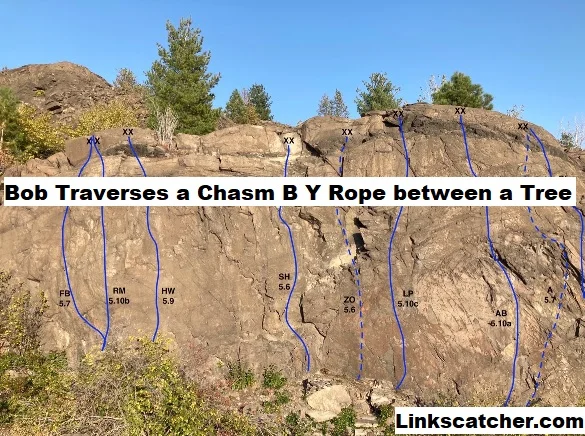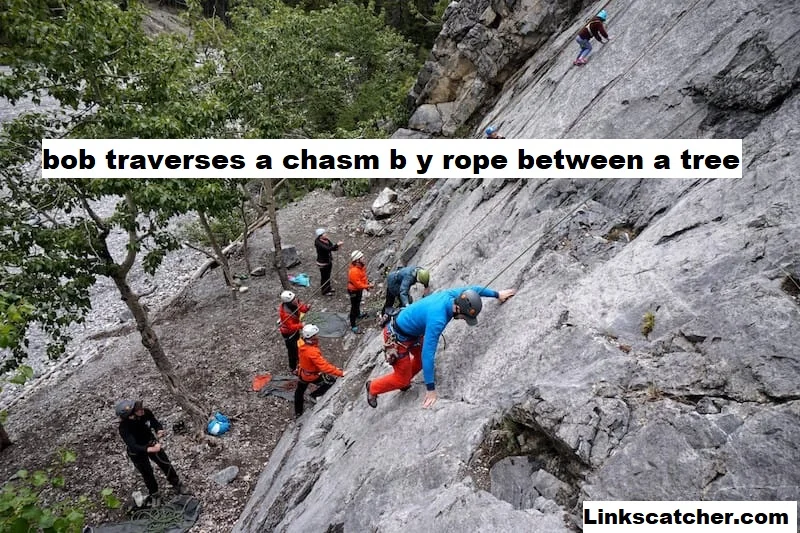
Imagine standing at the edge of a vast chasm, heart racing as you prepare to cross. Bob traverses a chasm b y rope between a tree finds himself in such a thrilling predicament, armed only with a rope tied between two sturdy trees. This daring adventure is not just about bravery; it’s grounded in physics and engineering principles that make such feats possible. Join us as we unravel the steps Bob takes to traverse this challenging gap safely and effectively, all while diving into the fascinating science behind his journey. Get ready for an exploration filled with tension forces, sag distances, and more!
Introduction of Bob Traverses a Chasm B Y Rope between a Tree
Bob traverses a chasm b y rope between a tree adventure begins with a simple yet daring idea: crossing a chasm using just a rope. Two strong trees stand at either end, providing the perfect anchor points for his journey.
With every careful step, he feels the tension in the rope and the thrill of defying gravity. The balance of forces plays out dramatically as he inches across, embodying both courage and a solid understanding of physics principles.
Understanding the Concept
Traversing a chasm by rope between trees is an exhilarating challenge. It combines physics, safety, and a bit of adventure. Understanding the forces at play helps ensure success.
When bob traverses a chasm b y rope between a tree takes this leap, several factors influence his journey. The tension in the rope, gravity’s pull, and sag distance all come into play. Each element must be carefully considered for a smooth crossing across that daunting gap.
Step 1: Free body diagram
Creating a free body diagram is essential for visualizing the forces at play when bob traverses a chasm b y rope between a tree. This diagram helps break down complex interactions into understandable components.
By representing bob traverses a chasm b y rope between a tree the ropes, and gravity as vectors, we can analyze how these forces balance each other. It sets the foundation for deeper calculations and considerations in this adventurous endeavor.
Step 2: Given data and assumptions
To traverse a chasm by rope, we must gather essential data and make key assumptions. We start with the distance between the trees, height above ground, and weight of Bob.
Assuming ideal conditions helps simplify our calculations. We’ll ignore wind resistance and friction for this step to focus on the fundamental forces at play during Bob’s daring adventure across the gap.
Step 3: FBD analysis of the hanging point
Analyzing the hanging point through a free body diagram (FBD) is crucial. It helps visualize all forces acting on Bob as he hangs between two trees.
Identify tension in the rope and weight due to gravity, ensuring you understand their interactions. This step clarifies how these forces balance out, relevant for calculating safety measures during his daring traverse across the chasm.
Step 4: Applying Newton’s second law
Applying Newton’s second law is crucial in understanding the forces acting on bob traverses a chasm b y rope between a tree as he traverses the chasm.
In this scenario, we consider both gravitational force and tension in the rope. By analyzing these forces, we can determine how they interact and affect bob traverses a chasm b y rope between a tree movements across the gap safely while maintaining balance on his journey.
Step 5: Calculating sag distance for recommended safety range
To ensure safety while bob traverses a chasm b y rope between a tree, calculating the sag distance is crucial. This measurement helps maintain optimal tension in the rope, preventing potential accidents.
Using appropriate formulas, one can estimate how much the rope will dip under Bob’s weight. Proper sag not only enhances stability but also ensures he can safely maneuver across without excessive strain on the hanging point.
Step 6: Determining tension force for a quarter of the sag distance
To determine the tension force at a quarter of the sag distance, we must analyze how weight influences the rope’s behavior. The tension varies based on the angle formed by the sag and can be calculated using trigonometric functions.
By applying these principles, one can accurately estimate how much force is exerted on the rope. This step is crucial for ensuring safety while traversing challenging gaps like chasms.
Popular Questions and Explanations

Many curious minds have questions about Bob’s daring adventure across the chasm. What safety measures are in place? How does he ensure a secure grip on the rope? Each query reveals deeper insights into physics and risk management.
Understanding these aspects not only clarifies Bob’s journey but also emphasizes the importance of preparation. Exploring answers enhances our appreciation for such thrilling feats and their underlying principles.
Most Popular Queries from the Chapter
Many readers often wonder about the safety concerns when traversing a chasm by rope between trees. Questions about optimal knot techniques and gear selection frequently arise. Understanding these elements can significantly enhance confidence.
Another common query revolves around the physics of tension in ropes. How does sag affect stability? Exploring these concepts helps clarify why precise calculations are vital for safe crossings over chasms. Each question builds a deeper understanding of this adventurous endeavor.
Recommended Insights from Physics Textbooks
Physics textbooks offer valuable insights into the principles of dynamics and forces at play in scenarios like bob traverses a chasm b y rope between a tree rope traverse. They often illustrate real-world applications, emphasizing how Newton’s laws govern motion.
Additionally, these resources highlight practical examples of tension and sagging in ropes. Understanding these concepts enhances problem-solving skills essential for analyzing various physical situations effectively. This knowledge is crucial for both students and enthusiasts alike.
Additional Resources of Bob Traverses a Chasm B Y Rope between a Tree
For those eager to dive deeper into the physics of traversing a chasm, there are numerous resources available. Online platforms offer interactive simulations that visualize rope dynamics and tension forces.
Books on applied physics provide comprehensive insights that can clarify complex concepts. Exploring these materials will enhance your understanding and appreciation of the mechanics involved in bob traverses a chasm b y rope between a tree daring adventure across the gap between two trees.
Short Answer Insights
Bob’s journey across the chasm with a rope requires understanding key concepts in physics. Short answer insights often focus on practical applications, helping enthusiasts grasp essential principles quickly.
These bite-sized explanations clarify complex ideas. They make it easier for learners to visualize Bob’s adventurous feat and appreciate the science behind traversing gaps safely and effectively. This approach enhances problem-solving skills while igniting curiosity about real-world scenarios.
Importance of Studying Across Devices
Studying across devices enhances learning flexibility. Whether it’s a smartphone, tablet, or laptop, each device offers unique advantages. This adaptability helps students engage with content anytime and anywhere.
Moreover, using multiple devices can improve retention. Transitioning between platforms allows learners to grasp concepts from different angles. The diverse formats cater to various learning styles, making the educational experience richer and more effective for everyone involved.
Availability of Detailed Explanations
Finding detailed explanations is crucial when tackling complex concepts like traversing a chasm by rope. Comprehensive resources help bridge gaps in understanding, making challenging topics more approachable.
Many online platforms provide step-by-step guides and videos that break down the principles at work. Engaging with different learning materials can enhance comprehension and retention, ensuring an effective study experience for all learners.
Related Topics to Bob Traverses a Chasm B Y Rope between a Tree
Exploring topics like electricity opens up a world of understanding about energy flow and circuits. It’s fascinating how these principles relate to everyday life, from powering our homes to charging devices.
Oscillations, torque, rotational motion, solid state physics, thermodynamics, and electromagnetism are equally captivating. Each area offers unique insights that connect back to the fundamental laws governing movement and energy in our universe. Discovering these can enrich your knowledge profoundly.
Electricity
Electricity is a fundamental force driving modern technology and everyday life. It powers our homes, businesses, and devices, making it essential for convenience and comfort.
Understanding electricity involves exploring concepts like current, voltage, resistance, and circuits. These principles help us harness energy efficiently while ensuring safety in its usage. Grasping the basics of electricity opens doors to numerous applications across various fields.
Oscillations
Oscillations are fascinating phenomena observed in various systems, such as pendulums and springs. They occur when an object moves back and forth around a central position, often driven by restoring forces.
These movements can be periodic or dampened, depending on factors like friction or external influences. Understanding oscillations is crucial for fields ranging from engineering to music, where wave patterns play a significant role in sound production and signal transmission.
Torque and Rotational Motion
Torque is the rotational equivalent of linear force. The concept is crucial in understanding various physical phenomena, from simple tools to complex machinery.
Rotational motion describes how objects spin or revolve. This motion depends on factors like mass distribution and applied torque. Analyzing these elements helps predict behavior in physics and engineering applications alike.
Solid State Physics
It focuses on how atoms and molecules arrange themselves, influencing electrical and thermal conductivity.
This field is crucial for developing new technologies, like semiconductors and superconductors. Understanding these principles can lead to innovations in electronics, energy storage, and even nanotechnology applications that shape our everyday lives significantly.
Thermodynamics
Thermodynamics explores the principles governing energy, heat, and work. It plays a crucial role in understanding how systems interact with their surroundings. The laws of thermodynamics set the foundation for various scientific fields.
In practical applications, thermodynamics helps engineers design engines, refrigerators, and even power plants. By analyzing energy transfer processes, we can enhance efficiency and develop innovative solutions to modern challenges.
Electromagnetism
Bob traverses a chasm b y rope between a tree adventure of traversing a chasm by rope between two trees highlights the fascinating interplay of physics principles. Electromagnetism plays an essential role in understanding forces at work, from static electricity to magnetic fields influencing movements.
As bob traverses a chasm b y rope between a tree prepares for his daring feat, awareness of these concepts enhances safety and effectiveness. Exploring electromagnetism not only enriches our grasp of physical phenomena but also connects different areas within science.
Understanding how forces interact can lead to better solutions in real-life scenarios, making it a vital aspect of physics worth studying further.